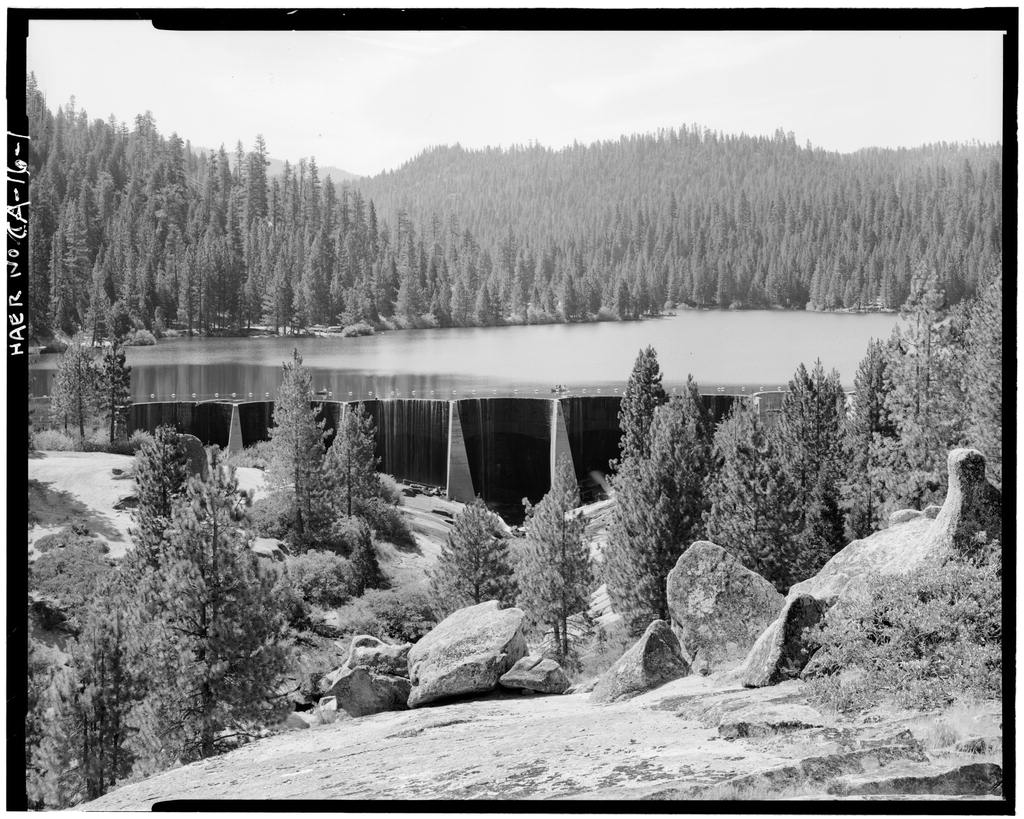Since the dam that created Hume Lake was built over a century ago, there have been some quick fixes and minor repairs. But the improvements recently accomplished are the most extensive to date and are expected to last another 50 to 100 years.
16 May 2016, The Kaweah Commonwealth

Direct descendant of a dam built to create a log holding pond in 1908, the dam that holds Hume Lake has undergone some quick fixes and minor repairs over the last 100 years. But the improvements accomplished in 2016 are the most extensive to date and are expected to last another 50 to 100 years.
In October 2015, after the area was determined to be safe from the encroaching Rough Fire and the reservoir’s water was no longer needed for firefighting efforts, Hume Lake was drained, scaffolding erected, and work began.
After significant grouting in all the cracks and crevices where some seepage was occurring, a Carpi dam lining system was installed. This is a waterproofing geomembrane lining that was installed on the upstream side of the Hume Lake dam and restored watertightness to the entire face.
“It’s a phenomenal system,” said Teresa Benson, Hume Lake district ranger. “We ended up with a complete lining of the former concrete dam.”
The project was completed in March and the lake was refilled. The total cost was about $3 million.
This coming fall the lake will have to be drained one more time for a scheduled maintenance project.
“But it won’t be for as long this time,” said Teresa.
History of Hume Lake
Construction on the dam began in June 1908 when the Hume-Bennett Lumber Company created Hume Lake as an 87-acre log-holding pond. This area of what has been Sequoia National Forest since July 1908 was formerly the site of extensive logging operations.
After working their way through Converse Basin, where they felled every giant sequoia except for one, the lumberers were looking for new timber stands to harvest. They settled on trees to the east of Converse Basin and built a large sawmill complex.
Working dawn to dusk, seven days a week, crews finished building the dam in 114 days. The cost of construction was $46,541, and the finished dam was 667 feet in length, 61 feet high, and contained eight miles of steel cable reinforcing 2,201 cubic yards of concrete.
The Hume Lake dam was the first concrete reinforced multi-arch dam to be built in the United States. It consists of 12 arches with the upstream faces sloped so water pressure exerted downward keeps the dam stable.
The reservoir provided a year-round water source for the flume that transported via gravity the lumber to Sanger in the San Joaquin Valley below.
Concurrently, work was occurring on a three-story mill complex located below the dam. By 1910, the area included two huge drying kilns, a boiler house, powerhouse, and foundry. The adjacent community had a housing complex, dining hall, post office, and hospital.
And although the logging activity was intense, the expenses of operation and maintenance were high. The mill had a difficult time making ends meet.
On April 8, 1935, the U.S. Forest Service purchased Hume Lake, Converse Basin, and surrounding lands totaling more than 20,000 acres for $319,276.75.
Today, Hume Lake provides water for the nearby campground, privately held cabins, Christian camps, fire suppression, and recreation, including fishing, swimming, and non-motorized boating.
